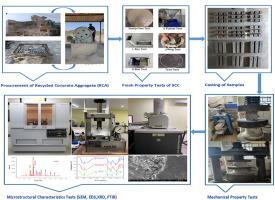自密实混凝土与花岗岩废料和再生骨料:一个新鲜的,机械的,微观结构的观点
IF 5.8
2区 化学
Q2 CHEMISTRY, MULTIDISCIPLINARY
引用次数: 0
摘要
来自建筑和花岗岩行业的重要副产品促使研究人员研究将废物整合到混凝土中的可持续方法,旨在减少其对环境的有害影响。目前的研究重点是用再生混凝土骨料(RCA)和花岗岩切割废料(GW)制成的自密实混凝土(SCC)的新鲜、硬化和微观结构特性。粗骨料在50%和100%的水平上部分被RCA取代,GW以10的增量代替细骨料,直到50%。通过坍落度流动、T500 mm流动时间、j型环、v型漏斗和l型箱试验评价了SCC的新鲜性能,通过抗压强度、弯曲强度和劈裂拉伸强度试验评价了SCC的硬化性能。添加50%和100%的RCA后,28天的抗压强度分别降低了约15%和25%。然而,添加30% GW后,在28天内,当RCA替换量为50%和100%时,机械强度分别显著提高了21%和13.5%。特别是,50% RCA和30% GW混合物在28天和90天的抗压强度超过了对照混合物。利用扫描电子显微镜(SEM)、能量色散x射线光谱(EDS)、x射线衍射(XRD)和傅里叶变换红外光谱(FTIR)进一步验证了硬化性能。研究结果表明,在RCA改性的SCC混合物中添加高达30%的GW可以提高机械性能,成功地抵消了RCA的机械缺陷,可以推荐作为SCC的可持续替代品。本文章由计算机程序翻译,如有差异,请以英文原文为准。

Self-compacting concrete with granite waste and recycled aggregate: A fresh, mechanical, and microstructural perspective
The significant by-products from the construction and granite industries have led researchers to investigate sustainable ways to integrate wastes into concrete, aiming to reduce their harmful environmental impacts. The current study focused on fresh, hardened, and microstructural properties of self-compacting concrete (SCC) made with recycled concrete aggregates (RCA) and granite-cutting waste (GW). Coarse aggregate was partially replaced with RCA at 50 % and 100 % levels, and GW was utilized as a replacement for fine aggregate at increments of 10 up to 50 %. The fresh properties of SCC were evaluated using slump flow, T500 mm flow time, J-ring, V-funnel, and L-box tests, while the hardened properties were assessed through compressive strength, flexural strength, and split tensile strength tests. Incorporating RCA at 50 % and 100 % reduced the compressive strength by approximately 15 % and 25 %, respectively, at 28 days. However, the addition of 30 % GW showed significant improvement in mechanical strength by 21 % and 13.5 %, for 50 % and 100 % RCA substitutions, respectively, at 28 days. In particular, the 50 % RCA with 30 % GW mix surpassed the compressive strength of the control mix at 28 and 90 days. Analyses using scanning electron microscopy (SEM), Energy dispersive X-ray spectrometry (EDS), X-ray diffraction (XRD), and Fourier transform infrared spectroscopy (FTIR) further validated the hardened properties. The findings showed that adding GW up to 30 % to RCA modified SCC mixes enhanced mechanical performance, successfully offsetting RCA's mechanical drawbacks, and can be recommended as a sustainable substitute in SCC.
求助全文
通过发布文献求助,成功后即可免费获取论文全文。
去求助
来源期刊

Sustainable Chemistry and Pharmacy
Environmental Science-Pollution
CiteScore
8.20
自引率
6.70%
发文量
274
审稿时长
37 days
期刊介绍:
Sustainable Chemistry and Pharmacy publishes research that is related to chemistry, pharmacy and sustainability science in a forward oriented manner. It provides a unique forum for the publication of innovative research on the intersection and overlap of chemistry and pharmacy on the one hand and sustainability on the other hand. This includes contributions related to increasing sustainability of chemistry and pharmaceutical science and industries itself as well as their products in relation to the contribution of these to sustainability itself. As an interdisciplinary and transdisciplinary journal it addresses all sustainability related issues along the life cycle of chemical and pharmaceutical products form resource related topics until the end of life of products. This includes not only natural science based approaches and issues but also from humanities, social science and economics as far as they are dealing with sustainability related to chemistry and pharmacy. Sustainable Chemistry and Pharmacy aims at bridging between disciplines as well as developing and developed countries.
 求助内容:
求助内容: 应助结果提醒方式:
应助结果提醒方式:


